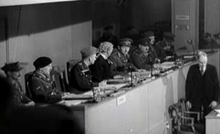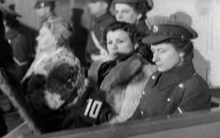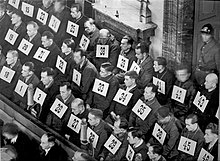Ravensbrück Trials
The Ravensbrück Trials comprise a series of legal proceedings that opened under British and French jurisdiction after the end of World War II . Members of the camp staff of the Ravensbrück concentration camp were accused . It was the large women's camp of the National Socialists, but men and boys were also imprisoned and murdered in the Ravensbrück concentration camp. Another trial of the Ravensbrück concentration camp took place in 1966 before the Rostock District Court in the GDR .
The trials under UK jurisdiction
From 1946 onwards, the British authorities carried out seven Ravensbrück trials - partly parallel to the Nuremberg doctor trial , in which the human experiments were treated in Ravensbrück and the Ravensbrück concentration camp doctors Carl Clauberg , Fritz Fischer , Karl Gebhardt and Herta Oberheuser were convicted. A military court was set up for this purpose . Between three and five British officers were appointed as judges, assisted by a legal advisor . The group of accused was made up of all ranks of the camp personnel: camp leaders, doctors, guards and also former prisoners who had mistreated other prisoners. A total of 38 people were tried, including 21 women.
All processes took place in the Hamburg Curiohaus as part of the Curiohaus processes .
First Ravensbrück Trial
Duration: December 5, 1946 to February 3, 1947
War crimes, mistreatment and murder of prisoners formed the complex of offenses of the proceedings, whereby crimes against German nationals were not considered in this proceedings. Major-General Westropp chaired the meeting, assisted by five officers from the British Army and a Polish major. Major Stewart was charged, and a Mister Stirling was present as legal advisor. The defendants had criminal defense lawyers of their choice at their disposal. Official observers from ten nations, press reporters and representatives of the German judiciary were present at the first Ravensbrück trial. A total of 16 defendants had to answer in court, all of whom pleaded “not guilty” at the beginning of the trial.
| Defendant (r) | Function in the warehouse | judgment |
|---|---|---|
| Johann Schwarzhuber | Protective custody camp leader, Ravensbrück women's concentration camp | Death by hanging |
| Gustav Binder | Deputy Operations Manager at Texled GmbH | Death by hanging |
| Heinrich Peters | Company commander of the SS Guard Battalion | 15 years imprisonment, released May 18, 1955 |
| Ludwig Ramdohr | Criminal Secretary, Head of the Interrogation Service in the Political Department (KZ) | Death by hanging |
| Martin Hellinger | dentist | 15 years imprisonment, released May 14, 1955 |
| Rolf Rosenthal | SS medical officer | Death by hanging |
| Gerhard Schiedlausky | SS medical officer | Death by hanging |
| Percival Treite | SS medical officer | Death by hanging, committed on April 8, 1947 suicide |
| Adolf Winkelmann | SS medical officer | died during the trial on February 1, 1947 |
| Dorothea Binz | Female entourage of the Waffen SS , deputy supervisor and head of the cell construction | Death by hanging |
| Grete Bösel | Female entourage of the Waffen-SS, labor service leader in the labor deployment office | Death by hanging |
| Margarete Mewes | Female entourage of the Waffen SS, head of the cell building | Ten years in prison, released on February 26, 1952 |
| Elisabeth Marshal | Head nurse, National Socialist Association of German Sisters | Death by hanging |
| Carmen Mory | Concentration camp prisoners, block elders in the infirmary, prisoner spies for the political department, interrogation service | Death by hanging; committed suicide on April 9, 1947 |
| Vera Salvequart | Concentration camp prisoners, prisoner nurses in the Uckermark death and selection camp | Death by hanging, executed June 2, 1947 |
| Eugenia from Skene | Concentration camp prisoners, block elders in the Siemens camp and camp runner in the labor office | 10 years in prison, released September 21, 1951. |
All those sentenced to death - with the exception of Vera Salvequart, Carmen Mory and Percival Treite - were hanged by Albert Pierrepoint in Hamelin between May 2 and 3, 1947 .
Two other defendants, camp commandant Fritz Suhren and labor leader Hans Pflaum , had fled from custody before the start of the trial and went into hiding using false names. However, they were arrested again in 1949 and handed over to the French occupation authorities, which had opened another Ravensbrück trial in Rastatt . Both defendants were there sentenced to death , and on June 12, 1950 shot .
Second Ravensbrück Trial
Duration: November 5 to November 27, 1947
In these proceedings only one defendant was tried. It was Friedrich Opitz , who ran the factory within the camp. Before the first Ravensbrück trial began, Opitz had managed to escape.
| Defendant (r) | Function in the warehouse | judgment |
|---|---|---|
| Friedrich Opitz | Plant manager of Texled GmbH | Death by hanging, executed February 26, 1948 |
Third Ravensbrück Trial
Duration: April 14th to April 27th, 1948 (also known as the Uckermark Trial)
Trials were held against five female camp officials from the Ravensbrück concentration camp and the Uckermark subcamp on the basis of the following charges:
- Allied prisoners mistreated
- Participation in the selection of Allied prisoners for the gas chambers of these two camps
The Uckermark youth concentration camp for girls and young women had been located one and a half kilometers east of the Ravensbrück concentration camp since June 1942 . The prisoners were considered to be criminals or difficult to educate. When they exceeded the age limit of 21 years, they were transferred to the Ravensbrück concentration camp. Both camps were under the same administration. From January 1945 the youth concentration camp Uckermark was dissolved. In the period that followed, the site served as a death and selection camp for sick women from the Ravensbrück concentration camp who were no longer able to work and who were older than 52 years.
| Defendant (r) | Function in the warehouse | judgment |
|---|---|---|
| Lotte Toberentz | Head of the youth concentration camp | acquitted |
| Johanna Braach | deputy head of the youth concentration camp | acquitted |
| Elfriede Mohneke | Overseer in the death and selection camp | 10 years imprisonment, released June 14, 1952 |
| Margarete Rabe | Overseer in the death and selection camp | Life imprisonment, converted to 21 years in 1950, released June 16, 1959 |
| Ruth Neudeck | Supervisor of the death and selection camp | Death by hanging, executed July 29, 1948 |
Toberentz and Braach were acquitted because they were not subject to women of Allied nationality in the youth concentration camp, but only to German prisoners. The fate of the German prisoners was not the subject of the proceedings.
Fourth Ravensbrück Trial
Duration: May to June 8, 1948
All of the accused belonged to the medical staff of the Ravensbrück concentration camp, including a prisoner who was used as a nurse. The charges focused on the ill-treatment, torture and murder of Allied prisoners in the gas chambers.
| Defendant (r) | Function in the warehouse | judgment |
|---|---|---|
| Benno Orendi | Camp doctor under Percival Treite | Death by hanging, executed September 17, 1948 |
| Walter Sunday | dentist | Death by hanging, executed September 17, 1948 |
| Martha Haake | Nurse | 10 years imprisonment, released on January 1, 1951 for health reasons. |
| Liesbeth Krzok | Nurse | 4 years imprisonment; released on February 3, 1951 |
| Gerda Ganzer | Camp inmate and nurse | Death by hanging, commuted to prison |
Ganzer had already been charged and acquitted in a Russian military court. The death sentence now imposed on her was later commuted to life imprisonment, which was eventually reduced to twelve years. She was released on July 6, 1961.
Fifth Ravensbrück Trial
Duration: June 16 to June 29, 1948; The verdict was pronounced on July 15, 1948.
Three members of the SS were charged with murdering prisoners.
| Defendant (r) | Function in the warehouse | judgment |
|---|---|---|
| Arthur Conrad | SS overseer | Death by hanging, executed September 17, 1948 |
| Heinrich Schäfer | SS overseer | 2 years imprisonment, released October 28, 1949 |
| Walter Schenk | SS overseer | 20 years imprisonment, released August 3, 1954 |
Sixth Ravensbrück Trial
Duration: July 1 to July 26, 1948
The two defendants were charged with mistreating Allied prisoners in the Ravensbrück concentration camp.
| Defendant (r) | Function in the warehouse | judgment |
|---|---|---|
| Kurt Lauer | SS overseer | 15 years imprisonment, released May 7, 1955 |
| Kurt Rauxloh | SS overseer | 10 years imprisonment, released on September 26, 1954 for health reasons |
Seventh Ravensbrück Trial
Duration: July 2 to July 21, 1948
In this last trial, six female guards were charged with ill-treating Allied prisoners and selecting prisoners for the gas chamber.
| Defendant (r) | Function in the warehouse | judgment |
|---|---|---|
| Luise Brunner | Superintendent | 3 years imprisonment |
| Anna Friederike Mathilde Klein | Superintendent | Acquittal for lack of evidence |
| Emma room | Superintendent | Death by hanging, executed September 20, 1948 |
| Christine Holthöwer | Overseer | Acquittal for lack of evidence |
| Ida Schreiter | Overseer | Death by hanging, executed September 20, 1948 |
| Use Vettermann | Overseer | 12 years imprisonment |
The trials under French jurisdiction
From 1949 to 1950 there were trials against members of the camp staff before the French military court in Rastatt .
On March 10, 1950, the court sentenced the former camp commandant Fritz Suhren and the labor operations manager Hans Pflaum to death. Both were originally to be indicted in the first British Ravensbrück trial. However, on November 16, 1946, they managed to escape from the British internment camp in the former Neuengamme concentration camp . After they were arrested again in March 1949, they were extradited by the Americans to the French and tried in Rastatt for multiple murders and sentenced to death on March 10, 1950. The verdict, confirmed on May 13, 1950, was carried out on June 12, 1950 by shooting Pflaum and Suhren.
literature
- Anette Kretzer: Nazi perpetrators and gender. The first British Ravensbrück Trial in Hamburg in 1946/47 . Metropol, Berlin 2009, ISBN 978-3-940938-17-6 .
- Ljiljana Heise: Concentration camp guards in court: Greta Bösel - “another of those brutal types of women?” . Lang, Frankfurt am Main / Berlin / Bern / Vienna 2009, ISBN 978-3-631-58465-1 (At the same time, Master's thesis at the FU Berlin 2007 under the title: The first Ravensbrück Trial (1946/47) and the question of perpetration of women under National Socialism ).
- Angelika Ebbinghaus (ed.): Victims and perpetrators. Women's biographies of National Socialism . S. Fischer Verlag, Frankfurt a. M. 1996, ISBN 3-596-13094-8 .
- Silke Schäfer: On the self-image of women in the concentration camp. The Ravensbrück camp. Berlin 2002 (Dissertation TU Berlin), urn : nbn: de: kobv: 83-opus-4303 , doi : 10.14279 / depositonce-528 .
- Eleven death sentences. Dr. Treite - helpers and murderers . In: Der Spiegel . No. 6 , 1947, pp. 3 ( online ).
- Ravensbrücker Mory deeds. Vera has a guilty conscience . In: Der Spiegel . No. 4 , 1947, pp. 4 ( online ).
Web links
- C. Taake: Indicted; SS women in court. ( Memento of March 3, 2008 in the Internet Archive ) Library and information system of the Univ. Oldenburg, 1998
Individual evidence
- ↑ Claudia Taake: Accused: SS women in court , diploma thesis at the University of Oldenburg , Bis, Oldenburg 1998, ISBN 3-8142-0640-1 , p. 70 ff.
- ↑ C Caterina Abbati: I, Carmen Mory. The life of a Bern doctor's daughter and Gestapo agent (1906–1947) . Chronos, Zurich 1999, p. 175, ISBN 3-905313-03-0 .
- ↑ Review: Anette Kretzer: Nazi perpetrators and gender. The first British Ravensbrück Trial in Hamburg in 1946/47. Berlin 2009. H-Soz-u-Kult, communication and specialist information for the historical sciences


